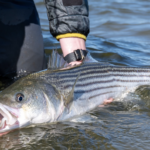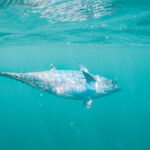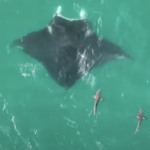
Talkin’ Striped Bass Spawn Dynamics
Consistent spawning production is paramount to a fishery’s long-term health. Many environmental factors are suspected
Tony Friedrich VP/Policy Director
In early August, the Atlantic States Marine Fisheries Commission (ASMFC) will decide whether to adopt a new strategy for menhaden management. Currently, menhaden are assessed and managed as a single species: Scientists assess the status of the stock in comparison with pre-established levels, or reference points, for fishing mortality (harvest) and stock size, and then decide how much fish can be harvested. The proposed new strategy would shift how those reference points are calculated by accounting for menhaden’s critical ecosystem role as a prey species.
The adoption of these new reference points, termed Ecological Reference Points (ERPs), would represent a huge leap forward in how managers consider the importance of forage fish when determining allowable harvest. More generally, it lays the groundwork for a broader shift toward management approaches that incorporate the complex web of interactions among species into decision-making—broadly termed Ecosystem-Based Fisheries Management.
This has not been an easy process. The scientists at the Atlantic State Marine Fisheries Commission (ASMFC) have been developing the model to inform ERPs for years. The model, called the NWACS-MICE model, considers population tradeoffs among menhaden, four menhaden predators (striped bass, bluefish, weakfish, and spiny dogfish), and one menhaden prey substitute (herring). It has been peer reviewed and is now considered the best available science.
Last week, NOAA held a webinar to review the findings from the ASMFC. We listened as Dr. Katie Drew, the ASMFC’s Stock Assessment Team Lead, did an incredible job of explaining a difficult topic. She was able to distill years of ERP development work into an hour-long webinar. She presented the information in a way that even I could understand (not an easy task). If you’re interested in viewing a recording of the webinar, you can do so on the NOAA Central Library YouTube Channel.
In February 2020, the results from the peer-reviewed ERP assessment were presented to the ASMFC’s Menhaden Board. The Board requested some additional analyses prior to voting in order to see how sensitive the ERPs were to assumptions about the status of other species in the model. The upcoming meeting in August, where the Board will formally consider whether to adopt ERPs for menhaden, is now where the rubber hits the road. If ERPs are adopted, a new quota for menhaden will be established at the October ASMFC meeting.
ERPs aren’t just a win for menhaden. They are a win for every fish we manage. It will be a multi-decadal effort, but that is the end game. Start with menhaden ERPs and work out from there.
At the end of July, ASGA will submit a letter to the ASMFC in support of ERP adoption. We will circulate that letter with a sign-on option prior to sending. Please be on the lookout for that. We need to get this done at this meeting.
ASGA was built to support the best science and best management. We don’t want to pick winners. For us, the winner should always be the resource. If the resource is healthy and managed well, all sectors should be able to operate without issues.
The one concern we have with menhaden ERPs stems from the fact that striped bass are the most sensitive species to menhaden abundance. This comes as no shock to striped bass anglers up and down the coast. If there are enough menhaden for striped bass, there should be enough menhaden for other predators as well. As a result, ASMFC’s scientists are designating the target menhaden ERP as the maximum menhaden fishing mortality that sustains striped bass at the biomass target when striped bass are fished at their target fishing mortality. Similarly, they set the threshold menhaden ERP as the maximum menhaden fishing mortality that sustains striped bass at the biomass threshold when striped bass are fished at their target fishing mortality.
Here’s the catch: ASMFC is also going to initiate a striped bass amendment process at the August meeting, which will take at least two years. If you recall, we have been warning everyone that the bad players, Maryland, New Jersey, and Delaware, are going to use the process as an opportunity to push for lower reference points for striped bass.
What happens if the reference points for striped bass are lowered? Beyond the obvious fact that there will be less striped bass for us to catch, it could also lead to a lowering of menhaden ERPs.
If we require less striped bass in the water by lowering the reference points, we also require less menhaden in the water to support striped bass and other predators. See where this is going? While we fully support ERPs, they bring a new dynamic to our job. Under single-species management, we could fight each battle one at a time. Now, the species will be intrinsically linked. One decision will have deep implications for each connected species.
We are hopeful that our advocates will recognize this and become more engaged. If you don’t, things could get ugly very fast. Now is the time to educate yourselves and become the best leader you can be. We are getting better management with ERPs but we could also be opening Pandora’s Box if we don’t stay deeply engaged.

Consistent spawning production is paramount to a fishery’s long-term health. Many environmental factors are suspected

While the ASGA team is extremely proud of the community we’re building with the Guide

Feature Image: A false albacore being landed off Jupiter Florida by the Cheeky Fishing team,

Feature Photo: “Best Practices for Fishing Cobia Around Manta Rays” The Florida Manta Project is
We rely on our members and donations to keep fighting for a sustainable tomorrow in marine conservation.
By using this website, you agree to our use of cookies. We use cookies to provide you with a great experience and to help our website run effectively. To learn more, please review our privacy policy.
8 Responses
A healthy bunker population supports so many other species, I have seen more bunker pods on the Jersey shore than ever before. Whales are feeding on them along with dolphins and other prey fish
The lower bay has been depleted of menhaden by the commercial fleet. Every September we see the menhaden ships of Buckroe beach and now the striper population has all but gone in Hampton Roads. Birds feeding over menhaden have disappeared. The past 5 years have been the worst for striper fishing that I have seen in 45 years.
Virginia’s portion of the Chesapeake Bay has localized depletion of menhaden. Something has to be done about the overfishing. It is affecting all wildlife and species that depend on menhaden for food. The benefit of menhaden as they filter the water is being missed in the bay as well. All other states on the east coast are doing better as they keep the fishing 3 miles out and have a lower percentage of the east coast quota. Why is the quota for Virginia 80 +%? This is wrong for the citizens of Virginia. The beautiful resource of the Chesapeake Bay does not deserve this.
You are exactly right on Virginia portion of approximately 80%. Our local representatives are responsible for the depletion of the bay species and should be run out of town and fired. This condition has been going on for years and will affect the bay for many more years.